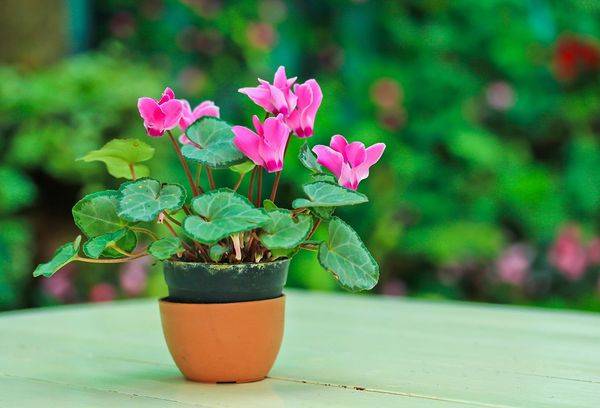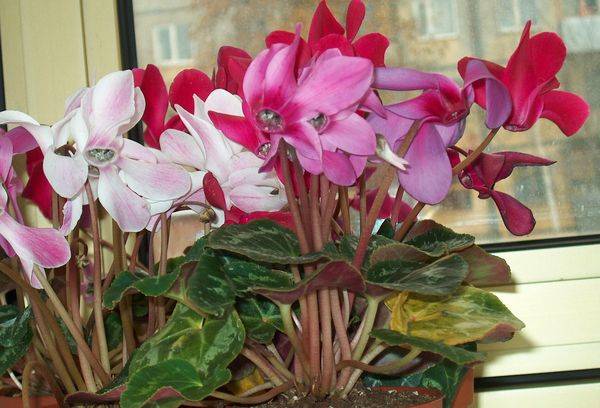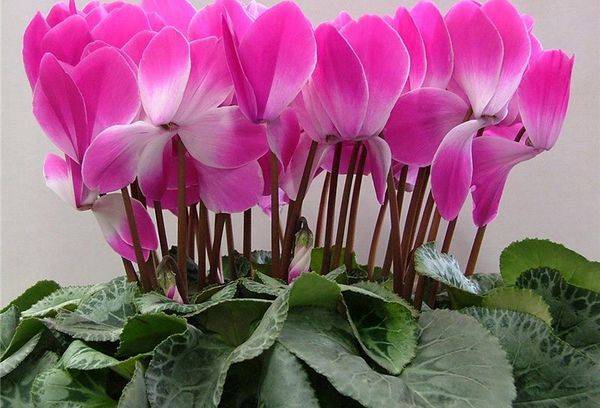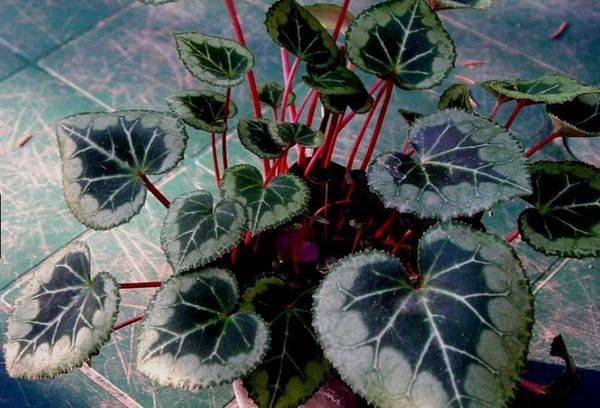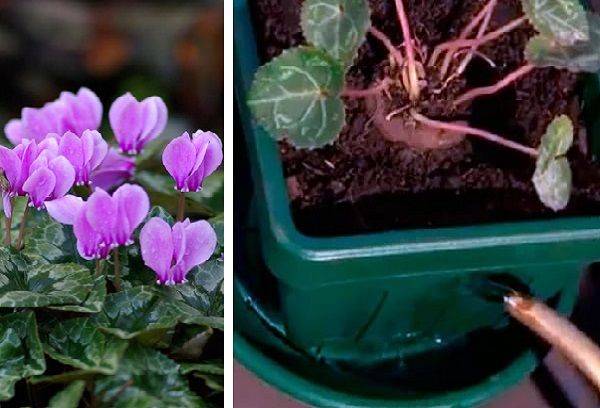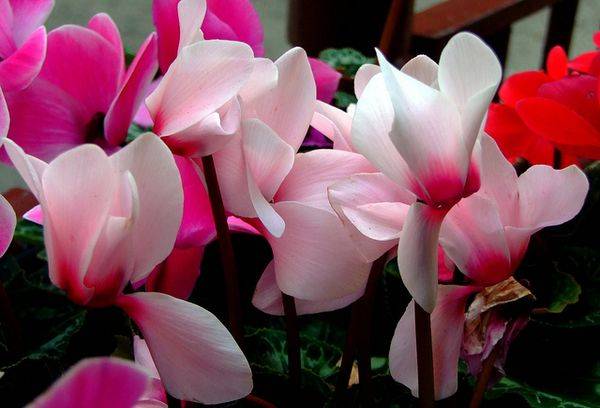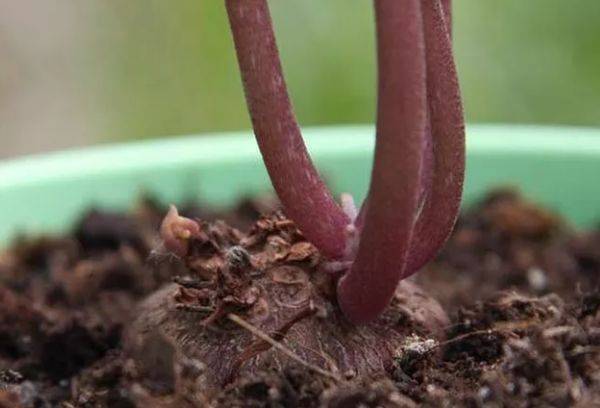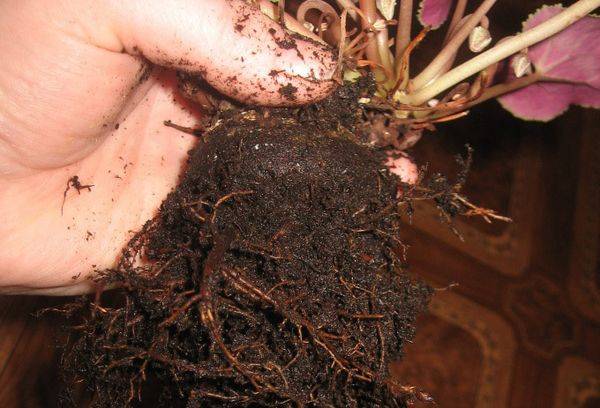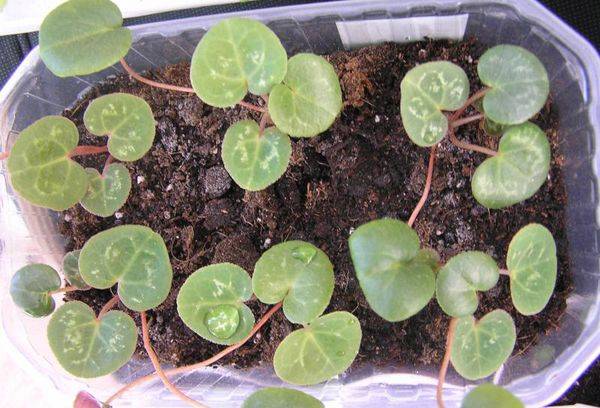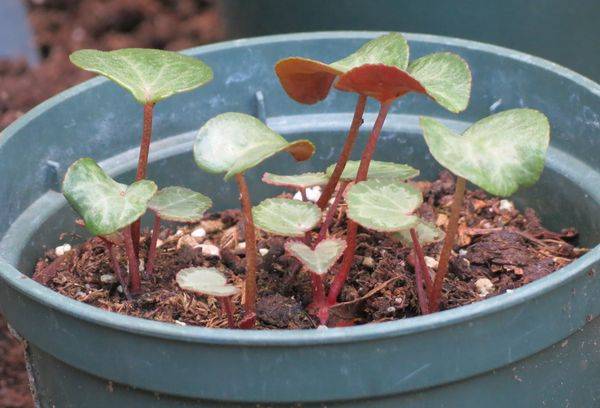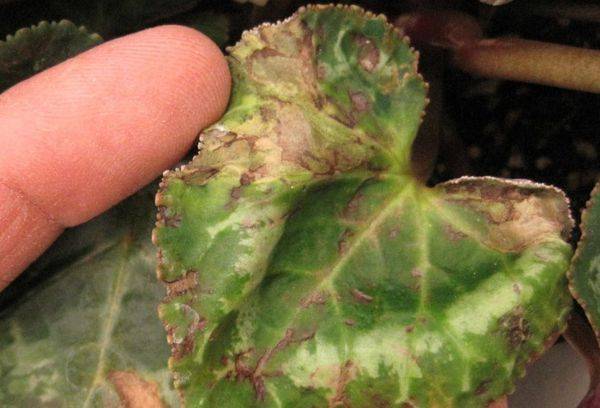Alpine violet or How to care for cyclamen home
Content:
- Description
- Varieties for growing in an apartment
- Placement in the house and temperature
- How to water a flower, air humidity requirements
- Care during flowering and dormancy
- Soil, fertilizers, transplant
- Breeding
- Why does the flower wither, leaves turn yellow, and other growing problems
- Cyclamen purchase
- Interesting Facts
Alpine violet, scum, butterfly flower - all these are the names of cyclamen home. The flower does not require complex care and is characterized by luxurious flowering. This makes it popular among both beginners and plant care masters. Read in this article about how to choose and grow cyclamen, what are the features of caring for cultivars, as well as details about the problems of cultivation.
Description
Cyclamen (Cyclamen) - a genus of plants with a rounded rhizome, as indicated by the Greek name (from the word "cyclos" - circle). It belongs to the family of primroses (sometimes - mirsinovyh). According to various sources, there are from 20 to 50 representatives of cyclamens. The homeland of the slander is the Mediterranean, Asia Minor, Central Europe and Iran. In home floriculture, the most popular cyclamen are Persian and European.
Alpine violet is known for its heart-shaped leaves adorned with silver marble patterns. The flowers are located on high peduncles, petals - 5, and they are slightly bent. At the base, the flower has a more saturated color, to the edges of the petal it becomes lighter. The fragrance exuded by flowering cyclamen is pleasant, “paper”.
A feature that makes cyclamen so popular in floriculture is the time of its flowering. The buds open in winter, and plant life cycles obey this feature. During the summer riot of colors, the alpine violet is in a dormant state. But in the fall, when most plants have bloomed, it comes to life, grows new leaves and forms buds. Flowering of different varieties of home cyclamen occurs in late autumn, winter and spring.
The main property that distinguishes home varieties of cyclamen from garden varieties is their relative thermophilicity. Especially demanding are hybrids of Persian cyclamen. Indoor care consists, first of all, in maintaining the right temperatures, taking into account the flowering time. In second place is watering and humidity. Soil, nutrients, and timely transplantation are also important.
Varieties for growing in an apartment
As already noted, two types of home cyclamen are most popular in indoor floriculture:
- Cyclamen is European, or purple. This is an evergreen medium-sized plant up to 15 cm high with an irregularly shaped tuber completely covered with roots. Rounded dark green leaves up to 5 cm in diameter have a silver pattern on the top and brown on the bottom. The edge of the sheet may be jagged. White, pink or red flowers (about 2 cm) expand upward, have bent petals and smell good. The flowering period is summer and autumn.
- Persian cyclamen - Turkish flower, amenable to selection. Hybridization of the Persian species began in the 19th century, and since then many varieties of this plant have been bred. They differ from each other in the color of the flowers: for some they are white, for others they are red or purple, almost all shades of pink, orange and lilac are also found. Petals are bent, grow up to 5 cm in length. Flowers appear on thin peduncles and stand from autumn to early spring. Cultivated varieties can stretch up to 30 cm in height - this is a tall group; up to 20 cm - medium-sized flowers, up to 15 cm - undersized.Leaves are large (up to 15 cm), dark green, bordered by a white or silver stripe. The tuber of the plant is spherical, dense, the roots are located in the lower part. The most popular varieties of Persian cyclamen in indoor cultivation: scarlet moth, belissima, spring moth, lilu, rose, Sifilda, topaz, charlie, elf.
Placement in the house and temperature
The main condition for the successful cultivation of cyclamens is compliance with the temperature regime. The plant is able to actively vegetate only in cool weather. When the air temperature rises, cyclamen begins to prepare for a period of rest. Therefore, in the room where the flower is grown, there should be from 13 to 16 degrees of heat. Allowable fluctuations in the summer to +25. In winter, a temperature of + 10˚C is considered a normal condition for flowering.
Hybrids of the Persian cyclamen are especially capricious: a temperature below +10 is as uncomfortable for them as a temperature above +16. Love for coolness is a small obstacle to keeping cyclamen, especially in apartments with heating systems.
Tip
In winter, in no case place a flowerpot with an alpine violet near the fireplace and battery.
In order to grow a flowering cyclamen, it is necessary to ensure the proper temperature regime. If these rules are neglected, then first it will cease to bloom, and then completely die.
The plant loves bright lighting, but direct sunlight damages the green mass. The best place for a pot in the summer is the west or east window. In winter, the junk will feel comfortable on the windowsill on the south side. A slight shading is acceptable. If the flowerpot is on the north side, then additional lamp lighting will be needed so that the plant does not suffer from a shortage of light.
How to water a flower, air humidity requirements
Cyclamens tolerate dry soil more easily than waterlogging, but it is better not to allow moisture to accumulate at the roots. Overflow leads to yellowing of leaves and rotting of the tuber. Therefore, you need to moisten the soil only after the top layer has dried. It is better to prevent moisture from entering the leaves and base of the tuber. This most often leads to a disease called gray rot. It is dangerous for the flower.
The recommended method of watering is through the pan. Place the pot for 10-15 minutes in warm water, then return to the place. An hour after watering, the excess liquid must be drained to avoid root decay. It is allowed to water in the usual way, only this is done very carefully, along the edge of the pot. The liquid should not fall on the base of the tuber and stems. Water for irrigation is soft, settled for at least 12 hours, 2-3 degrees cooler than room temperature. After flowering, the frequency of watering is reduced. And with the onset of summer, the amount of water is minimized - this time the plant needs in order to relax and get stronger.
Even if you have allowed the soil to completely dry, you still have time to reanimate the flower. Prepare a bucket or basin, fill it with water and put a flower pot there. The water level should not reach the edge of the pot by 1-2 cm. After this operation, wipe the pot and return to the pan.
Humidity is no less important than temperature. Cyclamen should be sprayed very carefully, without getting on the tuber, and even better not to spray the plant itself, but only the air around it. If the room is dry, place the flowerpot in a tray with wet moss and expanded clay. It is because of the dry air that you should not place flowerpots with flowers near working batteries.
Care during flowering and dormancy
How to care for cyclamen during the flowering period:
- The temperature for abundant flowering should be in the range from +10 to +14 degrees.
- You do not need to spray cyclamen during the formation of buds and when they open.
- Do not disturb the flowering plant (do not transplant).
- Water for irrigation should be 2-3 degrees colder than room temperature.
- Fertilizing does not stimulate the formation of buds, only green mass.
- When alpine violet flowers fade, they must be removed. This is done together with the peduncle: unscrew them from the base of the tuber completely. If left, they are highly likely to rot, which will lead to the death of the entire plant.
Typically, the flowering period of home cyclamen occurs in autumn, winter and early spring. With the onset of spring, the tubers are exposed, the leaves begin to turn yellow and fall off - this is the natural completion of the growing season. Like faded buds, wilted leaves must be removed.
The cycle ends by April-May, the plant goes into a dormant state. At this time, cyclamen also needs careful care:
- Top dressing stops.
- The number of irrigations is reduced.
- The tuber is stored in the ground, preferably in a cool, dark place (the basement is suitable).
- The room needs to be aired.
- Some varieties of cyclamens do not go to rest and never dump leaves.
In September, the plant begins to come to life, producing young leaves. To help cyclamen recover faster, lower the flowerpot into a basin of water and let the soil soak in moisture. Now resume normal watering, start fertilizing. At the same time, the plant is replanted or the topsoil in the pot is replaced with a fresh one.
Soil, fertilizers, transplant
If you take care of landing cyclamen in a suitable soil, then avoid a lot of problems. Butterfly flower loves a neutral or slightly acidic soil. Soil is bought in a specialized garden store or made independently. How to make a suitable primer:
- sheet land - 3 parts;
- humus - 1 part;
- peat - 1 part;
- sand - 1 part;
- You can add a little coconut fiber or rotted bark.
Cyclamen transplant is performed every 2 years. It is time to move the plant to a new pot when the tuber fills the entire space or the flower needs fresh soil.
Tip
If the flowerpot is suitable in size, then with the onset of autumn it is enough to replace the top of the soil with a new one. Do not plant cyclamen in large containers: this will lead to untimely flowering, buds will be small and quickly wilted.
Transplanted alpine violet in late summer or early fall, when he "wakes up." The pot for relocation is taken a little more than the previous one.
How to transplant cyclamen:
- take a suitable container;
- pour a drainage layer of expanded clay or crushed stone to the bottom;
- cultivate the soil for planting with a weak solution of potassium permanganate or fungicide;
- gently remove the tuber from the old pot;
- if there are rotten parts, they must be carefully removed;
- plant the scum in the ground, deepening the tuber by 2/3 (for Persian cyclamen) or completely (in other species);
- lightly crush the soil;
- put the flowerpot in a cool, bright place;
- increase watering as new leaves appear.
Top dressing continues throughout the period of active growth and flowering. Suitable universal liquid mineral fertilizers. purityis.decorexpro.com/en/ recommends the use of fertilizers in a concentration reduced by half. During the growing season they are applied 1 time per month. At rest, the plant does not need to be fed.
How to fertilize during the flowering period:
- when the height of the peduncle reaches 10 cm, the first top dressing is performed;
- the next - a week later;
- as a fertilizer, use a 0.01% solution of gibberellin (they are sprayed with leaves).
Breeding
Home cyclamen is propagated in the following ways:
- by seeds - the most popular way;
- tuber dividers.
Seeds purchased at the store retain viability for up to 2 years. They are sown in soil in September to a depth of 1 cm. And the first 20 days are stored in a dark place at a temperature of +20 degrees, regularly watering and airing. Create greenhouse conditions by covering the container with foil. After a month, move the pots to a well-lit place.When young leaves appear, transplant the seedlings into separate containers.
To get seeds at home, you need to pollinate an existing cyclamen. To do this, use a cotton swab to transfer pollen from one flower to another. It is better to repeat this procedure several times on a warm day, preferably in the morning. Ripened seeds are stored for 2 months, then soaked in the Zircon preparation and sown. Thus obtained alpine violets begin to bloom in the second, sometimes in the third or fourth year of life.
How to propagate the plant by dividing the tuber:
- The rhizome is dug up during dormancy and cut into pieces, leaving a root and a kidney on each.
- Slices are dried and treated with fungicide or crushed coal.
- Parts of the tuber are planted in separate pots.
- Capacities are covered with a film or a plastic cup.
Tip
When choosing planting material in the store, you need to pay attention to the appearance of the tuber. It should be resilient (not wrinkled), without spots of rot.
Why does the flower wither, leaves turn yellow, and other growing problems
What flower growers face when cultivating home cyclamen:
- The leaves turn yellow. This is normal after flowering, so the plant prepares for hibernation. Yellowness on the leaves at the wrong time is often caused by the high temperature in the room. Heat knocks down the natural cycle of the plant, and it begins to prepare for a period of rest.
- Cyclamen wilts due to a tight pot, lack of nutrients in the soil, pests and diseases.
- If the peduncles are shorter than the leaves, then you need to normalize the watering regime.
Flower Pests:
- Aphid. Alpine violet is covered with a white powder, similar to dandruff, is deformed and dies. As soon as you find an insect, urgently remove it with a swab dipped in soapy water or an insecticide.
- Thrips are wound on cyclamen in conditions of high temperature and low humidity. Parasites are easy to spot with the naked eye, so you should regularly inspect the underside of the leaf where they settle. A sign of the pest - the leaves become brown and fall off, the flowers become covered with sticky spots. The method of control is spraying with insecticides.
- When a cyclamen mite is damaged, a dust layer forms on the back of the sheet (in fact, this is an accumulation of parasites). The plant withers, the stems twist. All affected leaves must be removed, the flower treated with an insecticide.
Cyclamen Disease:
- Gray rot - a gray coating on the leaves, which is converted into brown soft spots. The infected plant must be transplanted into a fresh substrate and treated with fungicide.
- Blight rot - the drying of the lower leaves and peduncles, and subsequently the tuber. The treatment is the same as in the previous case.
- Fusarium - the plant turns yellow and dries out. The disease is difficult to notice, since a tuber affected by it does not outwardly differ from a healthy one. The method of struggle is watering with a solution of foundationazole.
Cyclamen purchase
A butterfly flower will be a good gift for a lover of indoor plants. It possesses not only magnetic beauty, but also a pleasant light aroma that will emphasize the festive mood. Before you buy a plant, you need to make sure that the sample assimilates in a new place and does not die.
Note:
- To the tuber. He should look a little out of the soil.
- Leaves. They should be resilient, bright, drawing - clearly visible.
- The density of the bush should be high.
Do not buy cyclamen with flaccid leaves. Plaque, mucus and mold on leaf plates is an excuse to refuse a flower. Such cyclamens can not only not take root, but also become a source of the spread of diseases. Better not endanger other green pets.
Interesting Facts
Cyclamen home is popular not only because of its beauty and relative unpretentiousness. Curious facts:
- In addition to alpine violet and butterfly flower, cyclamen has another unflattering name - “pork bread”.And the most striking thing is that pigs with an appetite and without harm to themselves eat cyclamen rhizome, although it is toxic to most animals.
- Alpine violet is not as popular as Christmas poinsettia, but it is also one of the most popular “live” gifts in the winter season.
- Cyclamen extract is used in medicine to treat runny nose and sinusitis.
- Popular sign: the flower takes away negative energy and processes it into positive energy, attracts love and finances to the house.
Even if you are a beginner grower, you can easily cope with growing cyclamen home. It not only decorates the interior, but also has a beneficial effect on the atmosphere in the room. It is also important that caring for such a beautiful green pet will give confidence to those who are just starting to be interested in indoor floriculture.
